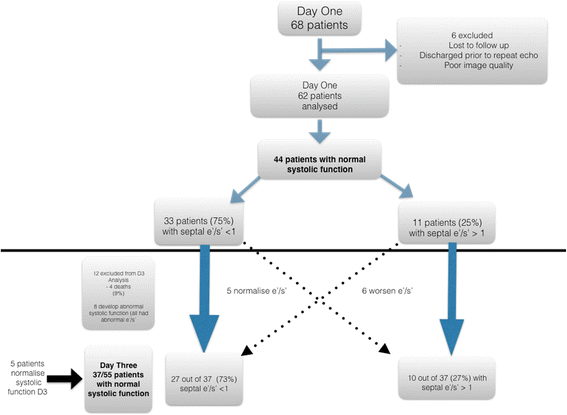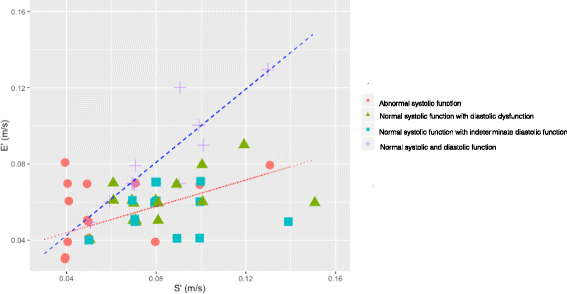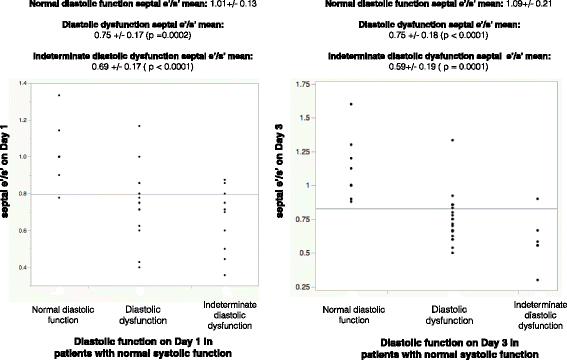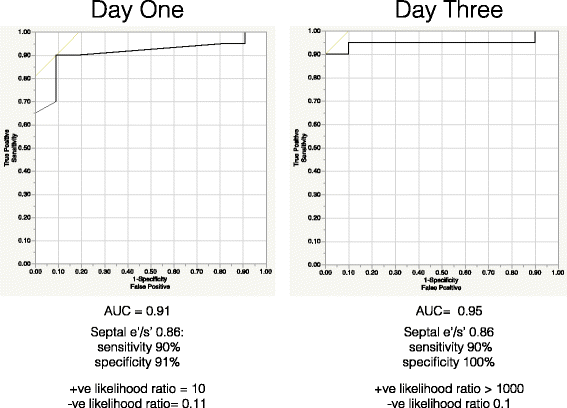Detecting impaired myocardial relaxation in sepsis with a novel tissue Doppler parameter (septal e'/s')
- PMID: 28705247
- PMCID: PMC5512826
- DOI: 10.1186/s13054-017-1727-9
Detecting impaired myocardial relaxation in sepsis with a novel tissue Doppler parameter (septal e'/s')
Abstract
Background: Left ventricular diastolic dysfunction is associated with mortality outcomes in severe sepsis and septic shock. There are ongoing issues with diagnosing diastolic dysfunction in this cohort, partly owing to the poor applicability of traditional parameters in the hyperdynamic circulation. In this feasibility study, we sought to assess the utility of a novel parameter (septal e'/s') to identify diastolic dysfunction in patients with severe sepsis and septic shock who had normal systolic function against the 2016 American Society Echocardiography and European Association of Cardiovascular Imaging (ASE/EACI) guidelines on diastolic dysfunction.
Methods: In this prospective observational pilot study, patients identified as having severe sepsis and septic shock underwent transthoracic echocardiography on day 1 and day 3 of their intensive care unit admission. In patients with normal systolic function, septal e'/s' was calculated using the peak modal velocity of the s' compared with the e' from the septal annulus tissue Doppler imaging and compared with their diastolic grade according to the 2016 ASE/EACI guidelines on diastolic dysfunction.
Results: On day 1 of admission, 44 of 62 patients with severe sepsis and septic shock had normal systolic function. There was a strong association of those with diastolic dysfunction having a reduced septal e'/s' compared with patients with normal diastolic function (AUC 0.91). A similar relationship was seen with patients who had indeterminate diastolic dysfunction. On day 3, 37 patients had normal systolic function. Again, there was a strong association of those with diastolic dysfunction and a reduced septal e'/s' (AUC 0.95).
Conclusions: A reduction in septal e'/s' may indicate diastolic dysfunction in patients with severe sepsis and septic shock who have normal systolic function. As opposed to limited traditional measures of diastolic dysfunction, it is applicable in those with hyperdynamic systolic function.
Keywords: Diastolic function; Myocardial relaxation; Sepsis.
Figures




Similar articles
-
Troponin elevation in severe sepsis and septic shock: the role of left ventricular diastolic dysfunction and right ventricular dilatation*.Crit Care Med. 2014 Apr;42(4):790-800. doi: 10.1097/CCM.0000000000000107. Crit Care Med. 2014. PMID: 24365861
-
Application of a simplified definition of diastolic function in severe sepsis and septic shock.Crit Care. 2016 Aug 4;20(1):243. doi: 10.1186/s13054-016-1421-3. Crit Care. 2016. PMID: 27487776 Free PMC article.
-
Prognostic Significance of Diastolic Dysfunction in Type 2 Diabetes Mellitus Patients With Sepsis and Septic Shock: Insights From a Longitudinal Tertiary Care Study.Cureus. 2023 Sep 25;15(9):e45894. doi: 10.7759/cureus.45894. eCollection 2023 Sep. Cureus. 2023. PMID: 37885490 Free PMC article.
-
Tissue Doppler assessment of diastolic function and relationship with mortality in critically ill septic patients: a systematic review and meta-analysis.Br J Anaesth. 2017 Oct 1;119(4):583-594. doi: 10.1093/bja/aex254. Br J Anaesth. 2017. PMID: 29121301
-
Systolic dysfunction as evaluated by tissue Doppler imaging echocardiography and mortality in septic patients: A systematic review and meta-analysis.J Crit Care. 2021 Apr;62:256-264. doi: 10.1016/j.jcrc.2020.12.026. Epub 2020 Dec 31. J Crit Care. 2021. PMID: 33461118
Cited by
-
Left ventricular diastolic dysfunction is prevalent but not associated with mortality in patients with septic shock.Intensive Care Med. 2025 Jan;51(1):94-105. doi: 10.1007/s00134-024-07748-2. Epub 2025 Jan 7. Intensive Care Med. 2025. PMID: 39774865
-
The impact of cardiac loading on a novel metric of left ventricular diastolic function in healthy middle-aged adults: Systolic-diastolic coupling.Physiol Rep. 2021 Dec;9(23):e15129. doi: 10.14814/phy2.15129. Physiol Rep. 2021. PMID: 34873864 Free PMC article.
-
Factors associated with left ventricular diastolic dysfunction in patients with septic shock.Eur J Med Res. 2022 Jul 27;27(1):134. doi: 10.1186/s40001-022-00761-5. Eur J Med Res. 2022. PMID: 35897043 Free PMC article.
-
Establishing a novel model to assess exercise capacity in chronic heart failure based on stress echocardiography.ESC Heart Fail. 2024 Dec;11(6):4335-4347. doi: 10.1002/ehf2.15038. Epub 2024 Sep 1. ESC Heart Fail. 2024. PMID: 39219247 Free PMC article.
References
Publication types
MeSH terms
LinkOut - more resources
Full Text Sources
Other Literature Sources
Medical
Molecular Biology Databases
Research Materials

